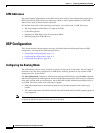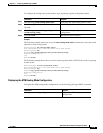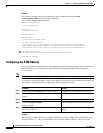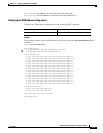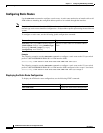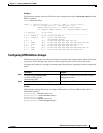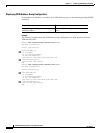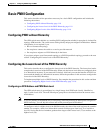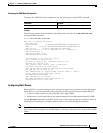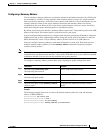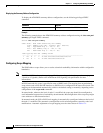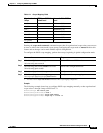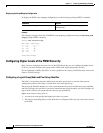
11-9
ATM Switch Router Software Configuration Guide
OL-7396-01
Chapter 11 Configuring ATM Routing and PNNI
Basic PNNI Configuration
Basic PNNI Configuration
This section describes all the procedures necessary for a basic PNNI configuration and includes the
following subsections:
• Configuring PNNI without Hierarchy, page 11-9
• Configuring the Lowest Level of the PNNI Hierarchy, page 11-9
• Configuring Higher Levels of the PNNI Hierarchy, page 11-16
Configuring PNNI without Hierarchy
The ATM switch router defaults to a working PNNI configuration suitable for operation in isolated flat
topology ATM networks. The switch comes with a globally unique preconfigured ATM address. Manual
configuration is not required if you:
• Have a flat network topology
• Do not plan to connect the switch to a service provider network
• Do not plan to migrate to a PNNI hierarchy in the future
If you plan to migrate your flat network topology to a PNNI hierarchical topology, proceed to the next
section “Configuring the Lowest Level of the PNNI Hierarchy.”
Configuring the Lowest Level of the PNNI Hierarchy
This section describes how to configure the lowest level of the PNNI hierarchy. The lowest-level nodes
comprise the lowest level of the PNNI hierarchy. When only the lowest-level nodes are configured, there
is no hierarchical structure. If your network is relatively small and you want the benefits of PNNI, but
do not need the benefits of a hierarchical structure, follow the procedures in this section to configure the
lowest level of the PNNI hierarchy.
To implement multiple levels of PNNI hierarchy, first complete the procedures in this section and then
proceed to Configuring Higher Levels of the PNNI Hierarchy, page 11-16.
Configuring an ATM Address and PNNI Node Level
The ATM switch router is preconfigured as a single lowest-level PNNI node (locally identified as
node 1) with a level of 56. The node ID and peer group ID are calculated based on the current active
ATM address.
Note If you are planning to implement only a flat topology network (and have no future plans to migrate to
PNNI hierarchy), you can skip this section and use the preconfigured ATM address.
To configure a node in a higher level of the PNNI hierarchy, the value of the node level must be a smaller
number. For example, a three-level hierarchical network could progress from level 72 to level 64 to
level 56. Notice that the level numbers graduate from largest at the lowest level (72) to smallest at the
highest level (56).




